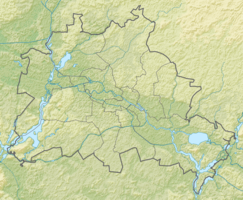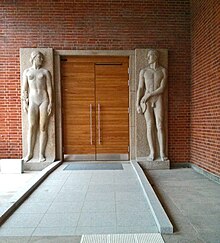Finckensteinallee swimming pool
| Finckensteinallee swimming pool "Fincke" |
||
|---|---|---|
 Finckensteinallee swimming pool |
||
| Data | ||
| place |
Berlin-Lichterfelde , Finckensteinallee 73 |
|
| architect | Karl Reichle, Karl Badberger , Wilhelm Weigandt |
|
| Construction year | 1937/1938 | |
| Coordinates | 52 ° 25 '54.8 " N , 13 ° 17' 52" E | |
|
|
||
| particularities | ||
| not public until 1994 | ||
The indoor swimming pool Finckensteinallee is a bathing and swimming facility in the Berlin district of Lichterfelde in the Steglitz-Zehlendorf district . It was opened in 1938, but was not available to the population until 1994. After extensive reconstruction by the operator, Berliner Bäder-Betriebe (BBB), it was opened to the public in August 2014.
history
The swimming pool, built in the typical Nazi architectural style on the site of the former Prussian Hauptkadettenanstalt ( Finckensteinallee 63-97), was the largest of its kind in Europe at the time with its 50 meter long and 25 meter wide pool . Karl Reichle, the senior government building officer Karl Badberger and Wilhelm Weigandt are named as architects for the extension buildings on the barracks site - gate buildings, farm buildings, storage facilities and swimming pool - but without a precise assignment of their objects.
Until 1994, the swimming pool was used exclusively for athletic training for the military - initially for members of the Leibstandarte SS Adolf Hitler .
After the Second World War , the facility was located in the American sector of Berlin and was used by the occupying forces. At that time it was called Andrews Barracks .
After German reunification and the withdrawal of the Americans from Berlin, the swimming pool became the property of the Berlin Senate , which transferred it to the Berliner Bäderbetriebe (BBB). Until 2006, only schools and clubs could practice in the pool. Because of increasing damage to the structure, the facility finally had to be closed.
The Senate provided around 13 million euros from the swimming pool refurbishment program for swimming pools and from the EU environmental relief program for a comprehensive renovation project . With this money, the architecture firm Veauthier Meyer Architekten removed all structural damage and implemented numerous energy-saving measures , including cladding the glass roof and reducing the water depth to two meters (for which the 10 m diving platform was dismantled). In addition, the interior walls were given fresh plaster and the pool operators renewed the building, ventilation and pool water technology. The official reopening took place on August 22, 2014 in the presence of the Senator for Interior and Sport, Frank Henkel , after the pool had previously been used for training for the recently held European Swimming Championships .
The Stadtbad has been open to all interested parties as a public sports facility since September 1st. Permanent users of the swimming pool are the swimming community Steglitz eV and the Zehlendorfer TSV (Z88) .
description
The swimming pool is a reinforced concrete structure and has a rectangular floor plan of around 73 meters × 33 meters. The narrow sides are drawn out in the manner of a Greek temple over a width of about 24 meters and are supported by brick square pillars. The pent roof is covered with gray roofing membranes. The entire structure is clinkered .
Inside there is a 50 m swimming pool with ten lanes, which are provided with starting blocks on one narrow side. The pool with a capacity of 2500 m³ (before the renovation 4000 m³) is clad with light blue natural stone tiles, the handling with beige colored, small-format and non-slip tiles. On one long side, floor-to-ceiling multi-section windows let daylight into the system. The inscriptions “No running / Don't run” and “No smoking / Smoking forbidden” on the walls remind of the long period of use by the Americans . The shower and sanitary facilities are arranged opposite the window side. Above that there is a grandstand, and space for the jury for competitions is on the narrow side above the pool.
Additional equipment such as a non-swimmer pool, sauna or whirlpool are not available.
The swimming pool is part of the listed building monument Hauptkadettenanstalt . At the entrance to the swimming pool, which is lined with massive pillars and clinker-clad walls, there are larger-than-life stone figures on both sides. They show a naked woman and a naked man and, in their archaic representation, symbolize the National Socialist understanding of art .
Web links
- Swimming pool Finckensteinallee on the website of the Berliner Bäder-Betriebe
- Anett Kirchner: Finckensteinallee is going swimming again . In: Der Tagesspiegel , July 25, 2014.
- Sport in a monument - renovation of a Berlin swimming pool . In: BauNetz , August 22, 2014.
- Rolf Lautenschläger: Bathing for the leader . In: the daily newspaper , March 7, 2012.
- Cornelia Dörries: Not just pulling lengths . In: Deutsches Architektenblatt , February 26, 2015.
Individual evidence
-
^ Georg Dehio : Handbook of German Art Monuments. Berlin. Deutscher Kunstverlag 2006, p. 481.
First name and title of Badberger come from personal names> Badberger . In: Berliner Adreßbuch , 1938, Part I, p. 69. - ↑ a b Sebastian Höhn: A bath for 13 million. In: Berliner Zeitung , 23./24. August 2014, p. 18.
- ↑ SG Steglitz website ( Memento of the original from September 3, 2014 in the Internet Archive ) Info: The archive link was inserted automatically and has not yet been checked. Please check the original and archive link according to the instructions and then remove this notice. with information about the renovated and reopened swimming pool including some photos. Retrieved September 1, 2014.
- ↑ Entry in the Berlin State Monument List



